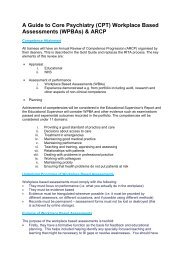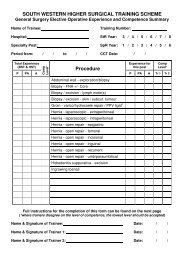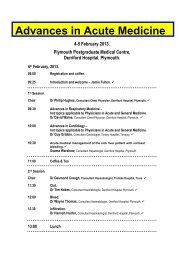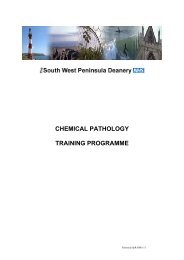Dr Andrea Magides & Dr D I Natusch South Devon Pain Service
Dr Andrea Magides & Dr D I Natusch South Devon Pain Service
Dr Andrea Magides & Dr D I Natusch South Devon Pain Service
Create successful ePaper yourself
Turn your PDF publications into a flip-book with our unique Google optimized e-Paper software.
<strong>Dr</strong> <strong>Andrea</strong> <strong>Magides</strong> & <strong>Dr</strong> D I <strong>Natusch</strong><br />
<strong>South</strong> <strong>Devon</strong> <strong>Pain</strong> <strong>Service</strong>
Picture courtesy of Astellas Pharma
The triple response of Lewis is<br />
a cutaneous response that<br />
occurs from firm stroking of the<br />
skin, which produces an initial<br />
red line, followed by a flare<br />
around that line, and then<br />
finally a wheal.The “Lewis<br />
Effect”.<br />
The triple response of Lewis is<br />
due to the release of histamine
picture
Ionotropic Receptor Subtype Ligand<br />
TRP 1,2,A Heat, Capsaicin, H+<br />
(A = noxious cold)<br />
Acid Sensing DRASIC ; ASIC H+<br />
Purine P2X3 ATP<br />
Serotonin 5HT3 SHT<br />
NMDA NR1 glutamate<br />
AMPA iGluRI glutamate<br />
kainate iGluR5 glutamate
Receptors) Subtype Ligand<br />
Glutamate mGluR1,2/3,5 glutamate<br />
Prostanoids EPI-4,IP PGE2, PGI2<br />
Histamine HI HA<br />
Serotonin 5HTIA, 5HT4,5HT2A 5HT<br />
Bradykinin B1,B2 BK<br />
Cannabinoid CB1-2 anandaminde<br />
Tackykinin NK1 Substance P,<br />
Neurokinin A<br />
Opioid Mu, Delta, Kappa Enkephalins
Congenital <strong>Pain</strong> Insensitivity seen rarely in<br />
humans and animals.<br />
Channelopathies / receptor defects.<br />
Recent studies have identified some families<br />
with genetic defects causing pain syndromes<br />
all of which affect peripheral nerve systems<br />
only.
Beggs et al. Molecular <strong>Pain</strong> 2010
Primary afferents contain excitatory amino acids (glutamate)<br />
and neurotransmitters (substance p). These depolarise AMPA<br />
receptors for a short and predictable time.<br />
Repeated C-Fibre input results in progressive membrane<br />
depolarisation and removal of the magnesium block from<br />
NMDA receptors (Windup) mediated by glutamate acting on<br />
NMDA receptors and Substance P on neurokinin receptors.<br />
Fast high density stimulation activates long-term<br />
potentiation. This with windup and sencondary hyperalgesia<br />
including the effect of wide dynamic neurones use partially<br />
overlapping systems all contribute to central sensitisation.<br />
Intense ongoing stimuli further excite transmission. And cause<br />
activation of cFOS genes and changes in cellular protein<br />
expression.<br />
Further excitatory processes involving many types of<br />
transmitter and messengers occur in the dorsal root ganglia.
Ketamine
Tyr-gly-gly-phe-met<br />
<br />
Tyr-gly-gly-phe-leu<br />
Small penta peptides that are made from precursors-<br />
Proenkephalin<br />
Pro-opiomelanocortin<br />
Prodynorphin<br />
Work on specific receptors – Cause a hyper polarisation<br />
of cells as a result of calcium influx leading to a<br />
decreased release of transmitters and decreased<br />
synaptic activity. Depending on the cell activity this can<br />
have a depressive or an excitatory effect.
Mu (morphine) MOP<br />
Kappa (ketocyclazocine) KOP<br />
Delta (vas deferens) DOP<br />
Nociceptin Orphanin FQ peptide receptor<br />
(NOP)
Classic opioid dose<br />
response curves you<br />
have been taught are<br />
not actually based on<br />
pharmacdynamic data<br />
in patients with pain.<br />
Nimmo and Smith 1994
Naturally occurring<br />
phenanthrene derivative<br />
Low lipid solubility and slow<br />
penetration of the bloodbrain<br />
barrier<br />
Extensively metabolised by<br />
gut wall and liver to<br />
M3G(70%) and M6G(10%)<br />
and sulphate conjugates<br />
M6G 10-20X more potent<br />
than morphine and is<br />
excreted in urine
„partial agonist‟ at mu opioid<br />
receptor, weak agonist at<br />
delta opioid sites and<br />
antagonist kappa opioid<br />
receptor.<br />
Intrinsic anti-tolerance<br />
effects
Buprenorphine has a ceiling effect for analgesia.<br />
*Buprenorphine induces a ceiling in respiratory depression but not analgesia.<br />
Dahan A et al, BJA 2006,96(5):627-32<br />
No evidence of a plateau (0.1-10mg) in humans.<br />
<br />
Buprenorphine is a partial agonist and will antagonise the effects of other<br />
opioids<br />
Persistent blockade of Mu/Mop receptor does not occur and subsequent use<br />
of other opioids is not affected in the acute or chronic situation.<br />
<br />
Lack of Naloxone reversibility of respiratory depression.<br />
Buprenorphine induced respiratory depression can be reversed by naloxone<br />
albeit in higher doses. BuddK, Budd K old dog- new matrix BJA 2003;<br />
90(6) 722-724
Weak agonist at all opioid<br />
receptors (MOP 20X)<br />
Inhibits neuronal reuptake of<br />
norepinephrine.<br />
Potentiates release of serotonin<br />
and causes descending<br />
inhibition of nociception.<br />
Metabolised by demethylation<br />
Several metabolites –one active<br />
(o-desmethyltramadol)<br />
Mu-opioid receptor agonist<br />
and norepinephrine<br />
reuptake inhibition<br />
Main metabolic pathway for<br />
elimination of tapentadol is<br />
phase II glucuronidation<br />
No active metabolites<br />
Low potential for drug-drug<br />
interaction<br />
TRAMADOL<br />
TAPENTADOL
Watkins Trends Pharcol 2009
Ensure other treatment options have been maximised.<br />
Consider opioid therapy as an adjunct ; sole opioid therapy is rarely<br />
successful.<br />
Use goal directed therapy; set limits and goals and agree to these.<br />
Unless pain is occasional base regime on long acting opioids and avoid<br />
breakthrough medication.<br />
Be prepared to wean and discontinue if treatment goals are not met.<br />
Ballentyne and LaForge K S. Opioid Dependence and addiction during<br />
opioid treatment of chronic pain.<br />
<strong>Pain</strong> 2007 ; 129 : 235-255<br />
<strong>Pain</strong> Clinic –negotiating firm limits
“The brain is an organ whose function is<br />
to make meaning”<br />
<strong>Dr</strong> Dorothy Rowe, Psychologist
Subconscious<br />
„detection system‟<br />
„messaging system‟ to central processing in the spinal cord<br />
and brain<br />
„message modulation‟ system<br />
automatic neural & endocrine changes and responses<br />
The Brain has the ability to processes information and at<br />
some level this becomes part of consciousness and has<br />
to make sense.
The gate control theory explains how counter stimulation<br />
helps pain but it was not sophisticated enough to explain<br />
central sensitisation.
Insular Cortex :”ouch it hurts<br />
but is it an important bit and<br />
what is the magnitude?”<br />
Anterior Cingulate Cortex<br />
“Alert : Something going on<br />
here!”<br />
Somatosensory Cortex<br />
“Its this bit”<br />
Thalamic Nuclei : ?? processing<br />
(pentium chip?)<br />
Pre frontal cortex<br />
“How does this relate to me in<br />
the outside world??”
Social pain activates the same<br />
Neuromatrix pattern as<br />
nociceptive input…<br />
Eisenberger, Science 302(5643): 290-2
Petrovic et al Science 2002
Moulin et al Lancet 1996
Hurt = harm (fear avoidance behaviours)<br />
<br />
Movement & re-injury (kinesiophobia).<br />
<br />
Worry - Catastrophisation<br />
Can interfere with movement and activity
Cognitive Behavioural Therapy in depression – Aaron Beck noticed<br />
depressed patients have depressive thinking and selectively access<br />
depressive memories. Uses Socratic Questioning techniques as a way<br />
of challenging automatic negative thinking alongside behavioural<br />
experiments. As effective as medication in mild / moderate<br />
depression. CBT has been adapted for <strong>Pain</strong> and may contain elements<br />
of relaxation / self hypnosis.<br />
<br />
Acceptance and Commitment Therapy : based around learning<br />
techniques for distress tolerance and acceptance of symptoms.<br />
Learning techniques of cognitive diffusion – notice thoughts but don‟t<br />
act on them and mindfulness medication developed from Zen<br />
Buddism.<br />
<br />
Compassion Focused Therapy – aims to teach compassion skills and<br />
self soothing techniques.<br />
<br />
Most Clinical Psychologists use elements of different therapies in<br />
individual therapy or groups (<strong>Pain</strong> Management Programmes)
CONGNITIVE - BEHAVIOURAL Bio-psycho-social MODEL Model OF PAIN<br />
<strong>Pain</strong> management unit
Stratified Care in Chronic <strong>Pain</strong><br />
<strong>Pain</strong>, disability<br />
And high distress<br />
<strong>Pain</strong>, disability<br />
and low Distress<br />
Chronic <strong>Pain</strong>, low disability low distress
How your brain works!
Receptor Specificity<br />
Noradrenaline<br />
Serotonin<br />
NA+5HT<br />
"NARIS"<br />
Reboxetine<br />
"SSRI"<br />
Fluoxetine<br />
"SNRI"<br />
Venlafaxine<br />
"NASSA"<br />
Mirtirzapine<br />
"RIMA"<br />
Moclobemide<br />
"MAOI"<br />
"TRICYCLICS"<br />
Amitriptyline<br />
Nortriptyline<br />
Lofepramine
Tricyclic Antidepressant<br />
Its metabolite Nortriptyline is equipotent but<br />
has fewer cholinergic and sedative side<br />
effects.<br />
TCA‟s in dosing studies have maximal effect<br />
for pain around 70mg.
Duloxetine<br />
Serotonin Noradrenaline Reuptake Inhibitor.<br />
<br />
It is effective for depression and generalised anxiety<br />
disorder.<br />
NICE Guidelines for Neuropathic <strong>Pain</strong> – first line<br />
treatment for neuropathic pain in diabetes.
ANTICONVULSANTS<br />
Enhance inhibition of<br />
GABA<br />
VALPROATE<br />
CLONAZEPAM<br />
Stabalise cell<br />
membranes<br />
PHENYTOIN<br />
CARBAMAZEPINE<br />
Bind to calcium or<br />
sodium channels<br />
GABAPENTIN<br />
PREGABALIN
Gabapentin and Pregabalin do not act on GABA receptor but<br />
A2 Delta receptor ( Calcium Channels).<br />
Effective in Neuropathic <strong>Pain</strong> and Pregabalin is a first line drug for<br />
neuropathic pain according to NICE Guidelines.<br />
Perioperative gabapentinoids (gabapentin/ pregabalin) reduce<br />
postoperative pain and opioid requirements (U) and reduce the<br />
incidence of vomiting, pruritus and urinary retention, but increase the<br />
risk of sedation (N) (Level I).<br />
Perioperative use of gabapentin after mastectomy reduced the incidence of<br />
neuropathic pain at 6 months postoperatively, from 25% in the placebo to<br />
5% (Fassoulaki et al, 2002 Level II).
Pictures from a variety of sources including <strong>Dr</strong> Howard Fields with<br />
permission, <strong>South</strong> <strong>Devon</strong> Archive and Wikipedia unless referenced.
















